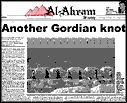
29 Nov. - 5 Dec. 2001
Issue No.562
 |
Al-Ahram Weekly Online 29 Nov. - 5 Dec. 2001 Issue No.562 |
||
| Published in Cairo by AL-AHRAM established in 1875 | Current issue | Previous issue | Site map | ||
The siege of Kandahar
If the fall of Kunduz is anything to go by, the siege of Kandahar could be a bloody exchange, writes Absar Alam from Islamabad
The siege of Kunduz dragged on for two weeks. Its fall to the Northern Alliance (NA), backed by the US-led coalition, means that the Taliban have not only lost their last stronghold in northern Afghanistan, they have also lost a huge number of military troops who were concentrated in this city.
Northern Alliance fighters on the frontline ahead of the takeover of Kunduz; a tank mistakenly destroyed by a US jet near Mazar-i-Sharif (photos: AFP & AP)
With the fall of Kunduz, the Northern Alliance -- which at the start of this month commanded less than 10 per cent of the country -- is now in complete control of northern and central Afghanistan. The focus of the coalition war machinery is now shifting to the southern military stronghold of Kandahar, the Taliban's spiritual capital.
Hundreds of US marines have already landed around Kandahar and more are likely to parachute into southern Afghanistan to join the ground operation launched by the US-led coalition. An airstrip near Kandahar has already been captured while Spin Boldak, a border town under Taliban control near the Pakistani city of Chaman, has already been cut off from Kandahar. A column of armoured personnel carriers was also attacked by US aircraft, but the coalition is tight-lipped about the nature of the military operation on the ground and the number of casualties, if any.
Earlier this week blood and brutality followed the fall of Kunduz to the NA, which conducted house-to-house searches looking for hidden Taliban forces, shot down wounded prisoners and left them to die in the city's marketplace. A prison revolt later erupted at Qala-i Jhangi, the 19th- century fort in Mazar-i Sharif where the Taliban fighters who had surrendered earlier in the day were taken.
Sources say that the revolt by Taliban guerrillas -- many of them non-Afghan Arabs, Chechens and Pakistanis -- erupted on Sunday. NA sources said the main holdout was confined to one tower of the sprawling fort, or qala, where they had been imprisoned. The fighting was fierce as the Taliban forces appeared to be fighting to the death. The result was 600 POWs dead.
According to witness reports gunfire and grenade explosions were heard as US warplanes flew over the fort. NA officials confirmed that hundreds of imprisoned foreigners were killed either by US jets that bombarded the fort or by the NA. At least 150 NA troops were also killed in the fight. The fight continued until Monday, when a group of Taliban soldiers remained holed up in a basement with a huge cache of weapons.
Nazir Hussein, an assistant professor at Islamabad's Quaid-i Azam University, says that the bloodbath of the Mazar-i Sharif jail riots is a case of history repeating itself. In 1998, when Taliban forces took over Mazar, the troops gathered NA prisoners in the same jail and later killed hundreds of them in the same fashion as this week's killings.
According to defence analysts, the highly secret decision to send in heavily armed US marines into southern Afghanistan marks a shift in America's war strategy. This is the first time that the US has deployed a large number of ground troops in Afghanistan since the war began on 7 October. The US has preferred to keep troops of other allied countries away from the operation and it has warned all journalists against travelling to Taliban-controlled areas. Though Britain had already sent 500 troops to guard Bagram Airport in the vicinity of capital Kabul, the US has shown it is reluctant to deploy more British troops in Afghanistan. British Prime Minister Tony Blair was forced to absorb some painful criticism after the US gave Britain the cold shoulder following an offer of more British troops.
As the Taliban lose more ground, the US seems to have decided to go solo in the final fight for Kandahar. The exclusion of other allied troops from recent military operation supports reports that the US wants less influence for its coalition partners in the decision-making process.
It is also significant that the clandestine US operation to capture an airstrip near Kandahar was undertaken without the large-scale use of the proxy ground forces of the Northern Alliance. But local anti-Taliban Pashtun leaders were said to have assisted the US operation. It seems likely that the US would prefer the support of Pakistan- based Pashtun groups and Afghan tribal leaders in its latest military operation around Kandahar.
The strategy makes sense, as Kandahar is not only the spiritual centre of Taliban, it is also the strongest fort in Afghanistan and represents the majority Pashtun ethnic group. To make the final push for Kandahar successful, the support of Pakistan-based Pashtun and Afghan tribal leaders is essential as rival ethnic Northern Alliance troops will not be welcome in this part of Afghanistan.
© Copyright Al-Ahram Weekly. All rights reserved
 |
|
|||||||||||||||||
| ARCHIVES Letter from the Editor Editorial Board Subscription Advertise! |
WEEKLY ONLINE: www.ahram.org.eg/weekly Updated every Saturday at 11.00 GMT, 2pm local time weeklyweb@ahram.org.eg |
Al-Ahram Organisation |